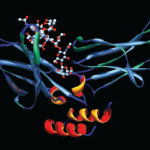WASHINGTON, D.C.—For rheumatologists treating patients with systemic lupus erythematosus (SLE), new research into factors that may lead to life-threatening comorbidities could provide clearer direction on how to treat this population, according to researchers at the 2012 ACR/ARHP Annual Meeting, held here November 9–14. [Editor’s Note: This session was recorded and is available via ACR SessionSelect at www.rheumatology.org.] At the Rheumatology Research Foundation Edmond L. Dubois Memorial Lecture, five investigators presented data on what plays a role in the development of serious comorbidities like lymphoma and thrombosis.
Hydroxychloroquine Use and Thrombosis
In her presentation, Genevieve Law, MD, a researcher at the University of Alberta in Edmonton, examined connections between hydroxychloroquine use and increased thrombosis risk. Women with lupus are more than twice as likely to be admitted to the hospital for a stroke or a myocardial infarction as those without SLE, Dr. Law said.
Higher thrombosis rates may be due to chronic inflammation, renal disease, vasculitis, and high-dose prednisone use. However, hydroxychloroquine may have a thromboprotective effect, she added. Dr. Law and her colleagues enrolled 1,795 patients from the Hopkins Lupus Cohort with no history of thrombosis and found 193 thrombotic events total, including 106 arterial, 83 venous, and four events that were both arterial and venous. Higher prednisone dose, such as 20 mg a day, nearly triples the rate of thrombotic events. Cumulative prednisone use also affects risk but not as strongly, Dr. Law said.
Hydroxychloroquine protects SLE patients from thrombotic events, especially after six months of consecutive use, and the protection is greater in patients who are positive for antiphospholipid (aPL) antibodies, the researchers found. As for nonsteroidal antiinflammatory drug use, naproxen is associated with a lower risk of thrombotic events because of its strong antiplatelet effect, while aspirin at 81 mg a day increased the risk, Dr. Law said. So medications are both an important risk factor and a modifiable one, she concluded.
Lymphomas in Lupus
In her presentation, Sasha Bernatsky, MD, PhD, assistant professor of medicine at McGill University in Montreal, explored the risk of lymphomas in lupus. Out of 15,980 SLE patients from 30 centers, 641 cancers were found. Researchers saw an increased risk of hematologic cancers, especially non-Hodgkin’s lymphoma and leukemia, Dr. Bernatsky said. She looked at how drugs may mediate the risk of lymphomas versus disease activity. Drugs assessed were cyclophosphamide, azathioprine, methotrexate, mycophenolate mofetil, antimalarials, and glucocorticoids.
Although researchers could not establish a clear association between SLE disease activity and lymphoma risk, they did spot a trend toward greater exposure to cyclophosphamide in the cancer cases versus those patients who were cancer free. No one drug was seen as an independent risk factor for lymphoma in SLE, Dr. Bernatsky said. One trend the researchers detected was that, in less than half the lymphoma cases, the patient had been exposed at one time to one of the immunosuppressant drugs. Cumulative steroid use, at 10 mg a day for at least a year, was seen as increasing risk as well, she said.
Rheumatologists will still use drugs like cyclophosphamide to treat aggressive lupus despite their potential toxicity, she concluded. Elevated lymphoma risk in SLE is still relatively low, she added.
Hypertension in SLE Patients
In her presentation, Hong Fang, MD, professor of medicine at the Johns Hopkins University School of Medicine in Baltimore, explored poorly controlled hypertension in SLE patients. People with lupus have a 2.66-fold increased risk for cardiovascular events like stroke, poor renal outcome, and coronary artery disease compared with the general population, she said. Achieving better hypertension control in patients with SLE may improve those rates, she said.
In a recent study based on the Hopkins Lupus Cohort, Dr. Fang and her colleagues found that 1,655 out of 2,209 SLE patients had hypertension during participation, defined as a systolic blood pressure equal to or greater than 140 mm Hg, diastolic blood pressure equal to or greater than 90 mm Hg, or the use of any hypertensive medication.
Patients with hypertension were more likely to be older, male, African-American, have a higher body mass index, and have less education, she said. Higher disease activity plays a role, as well as a higher urine protein-to-creatinine ratio and average serum creatinine, she said. Prednisone use was also associated with higher hypertension rates.
Only 9% of patients in the study met the goal of reaching a systolic blood pressure of less than 120 mm, Dr. Fang said. Interventions like working with patients to reduce weight and prescribing hydroxychloroquine may reverse that trend, she added, even though the mechanism for why hydroxychloroquine is associated with less hypertension is still not understood.
Looking at Molecular Signatures in Lupus
In her presentation, Meggan Mackay, MD, MS, a researcher at the Feinstein Institute for Medical Research in Manhasset, N.Y., spoke about molecular signatures in lupus, differentiating patients dealing with inflammation from those grappling with an infection. SLE patients are more susceptible to serious infections due to both their disease and the immunosuppressant drugs used to treat it, Dr. Mackay said.
Dr. Mackay and her colleagues sought to utilize RNA microarray blood analysis to identify specific profiles that would differentiate a response to systemic inflammation and infection in acutely ill, hospitalized lupus patients. Three groups were studied—27 ill patients hospitalized with a suspected infection, 16 with stable lupus and no evidence of disease activity, and 20 healthy individuals. For all three groups, three milliliters of whole blood was taken over three days; a total of 239 whole blood specimens were taken across six clinical conditions, including flare and infection, and controls.
The goal was to discover whether molecular signals associated with active lupus and no infection would differ from signals found in patients with both active disease flare and an infection.
Differences in upregulation of genes do suggest a gene expression gradient for disease activity in these acutely ill patients, Dr. Mackay said. Some highlights of the data are that significant upregulation of gene transcripts in interferon and plasma-cell modules differentiate subjects with a disease flare from those with an infection. Compared with stable lupus, acutely ill patients in both the flare and infection groups show an upregulation of genes in both the interferon and inflammation modules studied, she said. In the infection group, there was also an upregulation of neutrophil and myeloid modules.
Examining Joint Arthroplasty Rates
Christina Mertelsmann-Voss, MD, a researcher at the Hospital for Special Surgery in New York, examined increased joint arthroplasty rates among patients with SLE in the United States from 1991 to 2005.
The chronic inflammation associated with SLE can lead to arthritis and joint destruction, increasing the need for joint replacement, Dr. Mertelsmann-Voss said. SLE outcomes are improving due to advances in therapy, but do better treatments lead to less joint destruction and a decreased need for joint replacements, she asked?
She and her colleagues looked at total and partial knee, hip, and shoulder replacement surgeries in SLE patients compared with patients who had no inflammatory or autoimmune disease. Looking at hospital code records, they excluded any people with a dual diagnosis of either rheumatoid arthritis (RA)/SLE or juvenile idiopathic arthritis/SLE that might also be causing joint destruction.
They identified 2,766,913 arthroplasties that included 4,253 surgeries involving lupus patients. In the noninflammatory group, rates almost doubled, while in the lupus group, they more than doubled. Rates of total knee replacements almost tripled, but the rate of total hip replacements decreased, she said.
The incidence of avascular necrosis in SLE patients decreased significantly, while the proportion of those with osteoarthritis significantly increased. In addition, the mean age at the time of arthroplasty for SLE patients rose from 47 to 57 years during the study. This change may be due to more-effective therapy preventing early, rapid joint destruction in SLE patients, she said. In addition, osteoarthritis (OA) as an indication increased dramatically, meaning that lupus patients, treated more effectively early on, are living longer and developing OA that requires surgery.
Smoking and Lupus Comorbidities
Smoking may also contribute to serious comorbidities in lupus, according to Elisabet Svenungsson, MD, PhD, professor of medicine at the Karolinska University Hospital in Stockholm, Sweden. Smoking is not only associated with several autoimmune diseases like RA or SLE, but is also known to be associated with the occurrence of autoantibodies like aDNA in lupus, said Dr. Svenungsson. Recent studies also suggest that smoking is a risk factor for venous thromboembolism in both the general and lupus populations, she added.
Dr. Svenungsson and her colleagues looked at data collected from 367 lupus patients in the Karolinska Lupus Cohort. Each were given detailed questionnaires and then interviewed about their smoking habits. Of these, 53% had never smoked, including 35% formerly and 19% currently smoking. They were also tested for the presence of several autoantibodies. Rates of lupus anticoagulant, aCL IgG, ab2GP1 IgG, and Triple aPL were higher among those who had ever smoked, Dr. Svenungsson noted.
However, a puzzling trend emerged. Pathogenic aPL antibodies were more common among the former smokers than the current smokers. Antibodies not associated with thrombotic events were more common in current smokers.
Factors like duration of smoking, age at the onset of smoking, and years since quitting showed no differences with regard to the aPL isotype, she said. Former smokers who were LA positive had the highest risk of having ever had a vascular event.
The data imply that there is a strong association between SLE patients being former smokers and the occurrence of aPL antibodies in rates of vascular events. Smoking is also an environmental risk factor linked to humoral immunity, Dr. Svenungsson noted, so smoking may cause vascular injury, contributing to the increased risk.
Susan Bernstein is a freelance medical journalist based in Atlanta.


